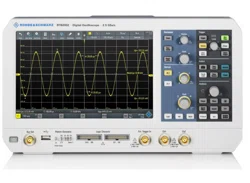Loading ...
Loading ...
Loading ...

SCPI Command Structure
R&S
®
RTB2000
469User Manual 1333.1611.02 ─ 03
* The asterisk marks a common command.
' '
"
Quotation marks introduce a string and terminate it (both single and double quotation marks are
possible).
# The hash symbol introduces binary, octal, hexadecimal and block data.
●
Binary: #B10110
●
Octal: #O7612
●
Hexa: #HF3A7
●
Block: #21312
A "white space" (ASCII-Code 0 to 9, 11 to 32 decimal, e.g. blank) separates the header from the
parameters.
Table A-3: Special characters
|
Parameters
A vertical stroke in parameter definitions indicates alternative possibilities in the sense of "or". The
effect of the command differs, depending on which parameter is used.
Example:
Definition:HCOPy:PAGE:ORIentation LANDscape | PORTrait
Command HCOP:PAGE:ORI LAND specifies landscape orientation
Command HCOP:PAGE:ORI PORT specifies portrait orientation
Mnemonics
A selection of mnemonics with an identical effect exists for several commands. These mnemonics are
indicated in the same line; they are separated by a vertical stroke. Only one of these mnemonics
needs to be included in the header of the command. The effect of the command is independent of
which of the mnemonics is used.
Example:
DefinitionSENSE:BANDwidth|BWIDth[:RESolution] <numeric_value>
The two following commands with identical meaning can be created:
SENS:BAND:RES 1
SENS:BWID:RES 1
[ ] Mnemonics in square brackets are optional and may be inserted into the header or omitted.
Example: HCOPy[:IMMediate]
HCOP:IMM is equivalent to HCOP
{ } Parameters in curly brackets are optional and can be inserted once or several times, or omitted.
Example: SENSe:LIST:FREQuency <numeric_value>{,<numeric_value>}
The following are valid commands:
SENS:LIST:FREQ 10
SENS:LIST:FREQ 10,20
SENS:LIST:FREQ 10,20,30,40
A.5 Structure of a Command Line
A command line may consist of one or several commands. It is terminated by one of
the following:
●
<New Line>
Structure of a Command Line
Loading ...
Loading ...
Loading ...
